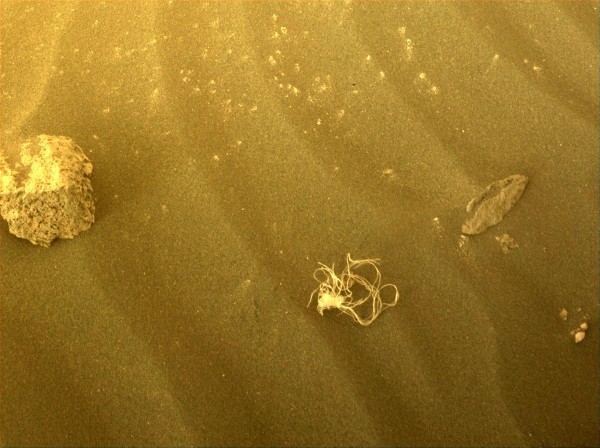While humans look for life on Mars, they also leave traces of themselves on the Red Planet in the form of trash - from metals and hardware to all kinds of junk you can find from a spacecraft.
NASA's Perseverance Rover captured last month a noodle-like object that perplexed the internet, raising the far-fetched possibility that there is pasta on Mars. How cool would it be to have ramen on Mars?
The object resembles a jumbled bundle of string, which was first seen by the Mars rover's camera on July 12 before suddenly disappearing four days later. But as it turns out, NASA said that this was nothing more than a piece of Dracon netting.
This weird-noodle-like object is only one of the thousands of human trash piled up on the Martian surface, all thanks to five decades of robotic exploration on the planet.
According to Cagri Kilic, Postdoctoral Research Fellow in Robotics at West Virginia University, there could be 15,694 pounds (7,119 kg) of human junk found on the Red Planet.

50 Years Worth of Trash
The last 50 years have seen 14 different countries send 18 human-made objects to Mars, according to the United Nations Office for Outer Space Affairs.
While many of these missions are still in progress, the planet's surface still contains countless pieces of human-made debris from decades of Martian exploration.
According to Kilic, there are three main sources of debris on Mars: discarded hardware, inactive spacecraft, and crashed spacecraft.
It is worth noting that every voyage to Mars needs a module that safeguards the spacecraft. This module includes a thermal barrier, a parachute, and landing gear for a soft impact as the craft travels through the planet's atmosphere.
As it descends, the craft throws away sections of the module, and these bits may land in various places on the planet's surface. This debris can shatter into smaller pieces when it hits the ground, which was proven in 2021 during the landing of the Perseverance rover.
Numerous little pieces of wind-blown trash, including the most recent discovery of netting material, have been found over the years. On June 13, 1.25 miles (2 km) from where it had landed, the Perseverance rover uncovered a large, sparkling thermal blanket.
Both Opportunity in 2005 and Curiosity in 2012 discovered leftover parts of their landing craft as well.
Historical Relics
Kilic that another type of debris comes from nine active spacecraft on Mars - such as the Mars 3 landers, Mars 6 lander, the Sojourner rover, the Beagle 2 lander, the Phoenix lander, the Spirit rover, and the Opportunity Rover.
Kilic said these might be viewed as historical relics rather than debris since they remain largely undamaged.
Another big source of trash is the fragments of destroyed spacecraft. At least two spacecraft have crashed, while four more have lost contact just before or after landing.
The most challenging aspect of any Mars landing mission is safely descending to the planet's surface, and it doesn't always go smoothly, according to Kilic.
He added that the combined mass of every spacecraft that has ever been deployed to Mars is around 22,000 pounds (9979 kilograms). Overall, there are 15,694 pounds (7,119 kilograms) of human trash on Mars.
Read also : NASA's James Webb Space Telescope Zooms in on Mars for the First Time, Capturing Stiking Martian Details!
The Significance of Trash
Currently, scientists' top concern is the risk that trash on Mars poses to ongoing and upcoming missions. The Perseverance teams are keeping track of every piece of debris they come across and looking for anything that can taint the samples the rover is gathering.
NASA engineers have also thought about the possibility that Perseverance might become entangled in landing debris, although they have determined that the risk is low.
Martian debris is still significant, according to Kilic, because of its historical value. The spacecraft and its components are a reminder of humanity's first steps toward planetary exploration.
Related Article : NASA Mars Perseverance Rover Captures a Sun Halo on Martian Sky
This article is owned by Tech Times
Written by Joaquin Victor Tacla




